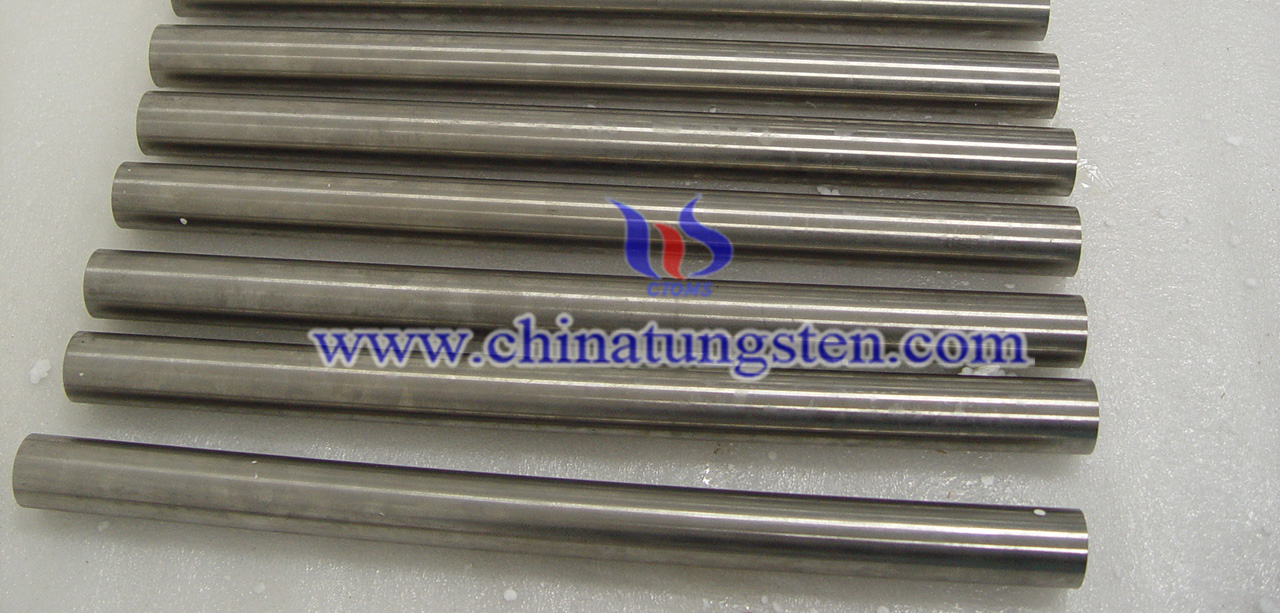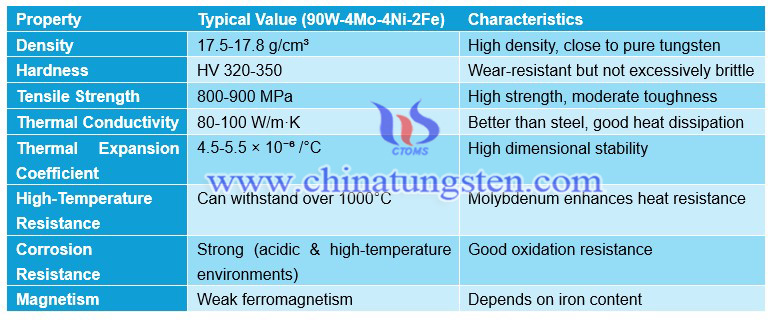
Properties of Tungsten-Molybdenum-Nickel-Iron Alloy
1. Physical Properties
? Density:
? Range: 17.0-18.5 g/cm3 (varies with tungsten content).
? Examples:
o 90W-4Mo-4Ni-2Fe: ~17.5-17.8 g/cm3
o 95W-1Mo-3Ni-1Fe: ~18.5 g/cm3
? Characteristics:
o Close to pure tungsten (19.25 g/cm3)
o Significantly higher than steel (7.8 g/cm3) or lead (11.34 g/cm3)
o Suitable for high-density applications
? Melting Point:
? The tungsten matrix has a melting point of 3422°C, but the presence of nickel (1455°C) and iron (1538°C) lowers the overall melting point.
? Since this alloy is typically processed via liquid-phase sintering, its melting point is not directly applicable in practical use. However, it remains highly heat-resistant, capable of withstanding temperatures above 1000°C.
? Thermal Conductivity:
? Range: ~80-110 W/m·K
? Comparison:
o Higher than die steel (~20-30 W/m·K)
o Lower than pure tungsten (173 W/m·K)
? Feature:
o Excellent heat dissipation, making it suitable for high-temperature applications.
? Coefficient of Thermal Expansion:
? Range: ~4.5-5.5 × 10?? /°C
? Comparison:
o Much lower than steel (11-13 × 10?? /°C) or aluminum (23 × 10?? /°C)
? Feature:
o High dimensional stability with minimal thermal deformation.

2. Mechanical Properties
? Hardness:
? Range: HV 300-450 (varies with tungsten content and heat treatment).
? Examples:
o 90W type: HV 320-350
o 95W type: Up to HV 400
? Characteristics:
o High hardness but lower than pure tungsten (HV 450-600)
o Strong wear resistance
? Tensile Strength:
? Range: 700-1000 MPa
? Example: 90W-4Mo-4Ni-2Fe: ~800-900 MPa
? Feature:
o High strength
o Nickel and iron enhance toughness, making it superior to brittle pure tungsten.
? Ductility:
? Elongation: 5%-25% (increases with higher nickel content).
? Feature:
o Significant improvement over pure tungsten, which has almost no ductility.
o Can withstand a certain degree of deformation without cracking.
? Compressive Strength:
? Range: 2000-2500 MPa
? Feature:
o Far exceeds ordinary steel
o Suitable for high-load or high-pressure environments
3. Chemical Properties
? Corrosion Resistance:? Stability:
? Stable under normal atmospheric conditions, resistant to decomposition and oxidation.
? Maintains structural integrity even at high temperatures (>600°C).
4. Other Properties
? Magnetism:
? The presence of iron (Fe) introduces weak ferromagnetism.
? Example: 90W-4Mo-4Ni-2Fe exhibits weak magnetism but is unsuitable for non-magnetic environments (e.g., MRI equipment).
? Compared to tungsten-nickel-copper alloys (which are non-magnetic), this alloy has distinct differences.
? Acoustic Properties:
? High density and hardness provide strong sound wave damping, making it suitable for vibration-damping applications.
? Machinability:
? Can be processed via turning, milling, and drilling.
? Superior to pure tungsten, which is hard and brittle.
? Nickel and iron act as binders, improving machinability.
Factors Affecting Properties
1. Tungsten Content:
? Higher tungsten (e.g., 95W): Increases density and hardness but reduces ductility.
? Lower tungsten (e.g., 90W): Improves machinability and toughness.
2. Molybdenum Content:
? Higher molybdenum (4%-10%): Enhances high-temperature strength and wear resistance but may slightly reduce density.
3. Nickel-Iron Ratio:
? High nickel (e.g., 5Ni-1Fe): Improves ductility.
? High iron (e.g., 2Ni-4Fe): Increases strength and magnetism.
4. Manufacturing Process:
? Liquid-phase sintering temperature (1300-1500°C) and cooling rate affect grain size and overall properties.
Summary of Properties

Chinatungsten specializes in manufacturing of tungsten alloy products. Any enquiry will be warmly welcomed by email to sales@chinatungsten.com or telephone to 0086 592 5129696.